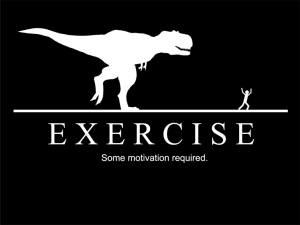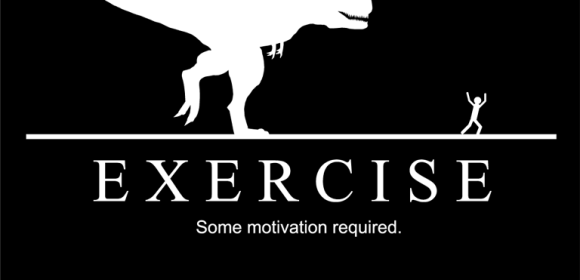If you look around the gym, some people workout happily, headphones in ears, as if it’s exactly where they want to be.

Others plod along or slack off, constantly checking to see if the torture is over yet…
People do the same thing for different reasons… And when it comes to finding motivation to achieve your health and fitness goals, there are two types you need to know about.
Intrinsic motivation is the self desire for achievement and success that comes from within. It is driven by the interest or enjoyment of the activity itself, and exists within you without the need for external rewards.
Extrinsic motivation is the complete opposite. Those driven by external rewards, like compliments, desire to win a race or competition, or fit into a dress.
And if you’re relying on the wrong form of motivation, you’re more likely to fail at reaching your goals.
Which one are you using right now?
To be successful, you must develop intrinsic motivation and become an “Inny”. The problem is, this doesn’t come naturally to us.
But there’s good news, this internal drive can be learned. It starts with you connecting with your desires.
When it comes to internal motivation, it’s all about being present in your current health and happiness, instead of being lost in future fitness, health and happiness.
Vague ideas about your future health and body are far less motivating than the post workout feeling of “Ah, I just rocked it. I need to do this again!” – which is enough to make an inny keep on pushing.
Negative Self-Sabotaging Thoughts
Ask anyone who doesn’t exercise on a regular basis why they don’t, and I bet they’ll rattle off a bunch of reasons. “I’m so busy at work”, “I get bored easily” or “I’m embarrassed to be seen at the gym”.
These folks hold (false) self sabotaging beliefs that exercise doesn’t matter. They don’t enjoy doing it, or they don’t have time. And seriously, who could blame them? It’s no fun to go and workout with negative thoughts constantly running through your head.
A person has to believe that exercise is of higher value in order to build motivation to go and do it.
Here are 5 strategies you can use to develop your “Inny”
Strategy 1: Develop High Self-Efficacy
Self-efficacy is similar to confidence and it’s the strongest predictor of your success. This term developed by psychologist Albert Bendura, is defined as one’s belief in their own ability to complete tasks necessary to be successful and achieve goals.
What does this mean?
If your goal is to lose 20lbs and you have a high level of self-efficacy you truly believe you will achieve this. You might have thought patterns that look like this:
“If I work hard, I will succeed”
“I’m sure of my ability to complete the tasks necessary to achieve my goals”
“I can change direction and overcome any obstacles that block my path”
On the other hand, a woman with low self-efficacy won’t lift a 40lb dumbbell if she believes she can’t – even if she is physically fit and strong enough to do so.
There are 3 ways to build self-efficacy:
=> Small success at the start
When you’re first starting out or getting back, do exercises you’re certain you can do successfully. If you’re a beginner, start with strength training bodyweight exercises, walking and light stretching.
Similarly, if you’re advanced and looking to take it to the next level, start small. You could add a few reps or an exercise to your strength workout, or you add a few minutes to your high intensity training.
=> Watch others succeed
This works particularly well being in this group coaching program, and if you have friends, family or co-workers who are at a similar level. Witnessing their successes can help boost your self-efficacy.
=> Encouragement
Personal trainers and coaches (like me) are highly skilled at giving the right encouragement. Make sure the feedback is based and focused on your progress, and not comparing yourself to others.
Strategy 2: Challenge Your Thinking
A rational thinker understands that nothing makes a person angry, upset or depressed – rather what a person thinks about things determines how they feel.
Like Henry Ford once said, “Whether you think you can, or you think you can’t – you’re right.” You must believe you can do it.

You will have ZERO motivation without winning this “inside game”.
But most people are not born knowing how to think rationally. And the good news is you can learn how to do it, even in the face of negative beliefs. “Automatic negative thoughts” or internal negative messages, can be obstacles to motivation and goal setting.
Examples of major destructive thoughts are:
- Feeling Inadequate: Emotional reasoning is mistaking feelings for facts. Negative things you feel about yourself are held to be true, because they feel true. “I feel like a failure, so I must be a failure.”
- No middle ground: All or Nothing thinking a tendency to view things that at the extremes with no middle ground. “I made so many mistakes today already. I might as well give up.” “I’m either on or off my diet, there’s no in between.”
- Mind reading: making assumptions about other people’s thoughts, without checking if they’re actually true. “I could tell the people at the gym thought I was weak.”
- Predicting Failure: fortune telling is anticipating failure and assuming your prediction is already fact. “I won’t be able to run for 5 minutes, and I’ll make a fool of myself in front of everyone, and I’ll fail.”
When these Negative Thought patterns attack, here are useful strategies and questions you can ask yourself:
- Am I focusing on the negatives and ignoring other information?
- How would my fit friend think if they were in this situation?
- Is it as bad as I am making out? What is the worst that could happen?
- What can I say to myself that will help me remain calmer and help me achieve what I want to achieve in this situation?
Strategy 3: Use SMARTER goals
With SMARTER goal setting, (Specific, Measurable, Achievable, Realistic, Timely, developed Enthusiastically and combined with Reward) you can eliminate the inconsistencies in your health and fitness routine.
Getting up in the morning and saying “I’m going to do 15 minutes of strength training and walk for 20 minutes today” is far less effective than saying “I’m going to 3 sets of 15 push ups, 3 sets of 10 squats etc, then walk on the treadmill at 4.0mph and 3% incline for 20 minutes…
SMARTER goals take the guesswork out of your fitness plan and make it more likely you’ll stick with it. And that’s why I always suggest you follow a structured program instead of random workouts.
Strategy 4: Commitment contracts
Putting your goals in writing and confirming them with another person is a powerful way to help you stick with your goal. Add a reward or penalty – and the stakes are even higher.
The concept of a commitment “contract” is exactly as it sounds: You commit to a friend, partner or accountability app to make a behavior change – and if you fail to do so, there is some kind of consequence (usually a monetary one).
The idea is that the desire to avoid consequence helps you stay committed to success.
Strategy 5: Make exercise fun!
Of the thousands of workout programs available, the ones with the most success stories use fun to engage people.
It doesn’t mean they’re careless, or not focused on getting sexy results. In fact, I make a point to add a fun element – it makes you feel like a kid again!
And let’s face it… A lot of the time training involves being challenged and sweating, so why not make it a place for laughter and hard work? ![]()
The Last Word
Without becoming an “Inny” it’s difficult to build lasting motivation to achieve your log term goals.
Believing in yourself, challenging your negative thoughts, using SMARTER goals, setting up a commitment contract and making your workouts fun, you can set yourself up for long-term success.
So tell me, what strategy are you going to use to develop your “Inny”? Let me know in the comments box below the post.
Rock on and have an awesome day!
KV













